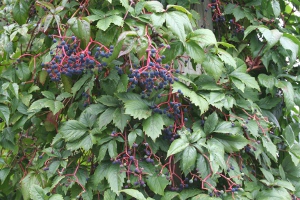Virginia Creeper (Parthenocissus quinquefolia)

Vines add visual appeal and habitat for wildlife. They can even be used to camouflage less pleasing areas of the garden, such as composters, concrete walls or ugly fencing. All it takes is a simple trellis, fence, string or sometimes nothing at all to support these climbing plants.
There are many vines native to Canada and, despite their shared habit of climbing up and gaining support from objects, they vary greatly in shape, texture, colour and other characteristics. You can find vines in many different plant families. Virginia creeper, a member of the grape family, is commonly seen around its native region of Ontario and Quebec, in woods and gardens, growing up trees and buildings as well as across areas as a ground cover.
What’s in a name?
The Latin “quinquefolia” refers to the plant having five leaflets in each leaf. The common name says it all — Virginia creeper will creep slowly and steadily along whatever you put in its path.
Uses

Virginia creeper is reputed to have been used by humans to alleviate jaundice, headaches, rheumatism, bunions, respiratory ailments and skin irritations such as poison sumac rash. (Caution: We are not recommending the use of these plants for medicinal or food purposes. Many plants are poisonous or harmful if eaten or used externally. The information on food and medicinal value is only added for interest. This information has been gathered from books and its accuracy has not been tested.)
Propagation
 You can grow this plant from seeds that have chilled in your freezer for a few weeks or that have been sown in the fall and allowed to overwinter. You can also grow them from cuttings. Place the cuttings in a jar of water and keep the newly formed roots protected from the sun with a cloth or paper. Plant once several roots have grown.
You can grow this plant from seeds that have chilled in your freezer for a few weeks or that have been sown in the fall and allowed to overwinter. You can also grow them from cuttings. Place the cuttings in a jar of water and keep the newly formed roots protected from the sun with a cloth or paper. Plant once several roots have grown.
Care
This plant loves sun and a place to climb, but seems very tolerant of shady areas and can thrive without support. Although it prefers moist soils, Virginia creeper can be grown in drier conditions. It can be an aggressive spreader but is easily kept in check if you cut it back once a year.
Growing native plants can be time- and money-saving and is rewarding to both us and our wildlife neighbours. To learn more about growing native plants in your garden, visit http://cwf-fcf.org/en/resources/online-articles/news/habitat/gardening-with-native-canadian-plants.html.


